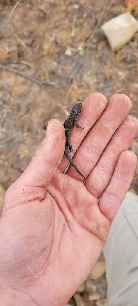Island Night Lizard (Xantusia riversiana)
Description: Island night lizards are typically between 2.6 and 4.3 inches in length, not including the tail. They typically live between 11 and 13 years, but some individuals are estimated to have lived 30 years or more. Their color varies from pale ash gray and beige to brown and black. They may have uniform, mottled, and striped patterns.
Habitat: The island night lizard's preferred habitat is coastal scrub made up of dense boxthorn and cacti thickets.
Range: The Island Night Lizard (Xantusia riversiana) is an endemic reptile found only on the Channel Islands, specifically on Santa Barbara Island, San Nicolas Island and San Clemente Island.
Found in these States:
CA
Diet: Island night lizards feed on a wide variety of terrestrial spiders and insects, but they also eat an unusually large amount of plant material for a small lizard.
Reproduction: Like other night lizards, the island night lizard bears live young rather than laying eggs. The island night lizard is much larger than another species in the genus Xantusia, the desert night lizard (Xantusia vigilis) of southern California.
Status: The Island night lizard was listed as a threatened species under the Endangered Species Act (ESA) in the United States since 1977; the International Union for Conservation of Nature (IUCN) lists the species as vulnerable. In 2006, the US Fish and Wildlife Service, the administrating agency for the ESA, removed the San Clemente subspecies from the ESA. Better control of munitions-sparked wildfires may have been a reason. In March 2014, The US Fish and Wildlife Service removed the species from the Federal List of Threatened and Endangered Wildlife. This removal was attributed to the removal of non-native animals such as cats and goats from the islands and partnering between the US Fish and Wildlife Service and the US Navy.
»» Kingdom: Animalia - Animals
»» Phylum: Chordata - Chordates
»» Subphylum: Vertebrata - Vertebrates
»» Class: Reptilia - Reptiles
»» Order: Squamata - Lizards
»» Family: Xantusiidae - Night Lizards
»» Genus: Xantusia
»» Species: Xantusia riversiana - Island Night Lizard
This article uses material from the Wikipedia article "Island Night Lizard", which is released under the Creative Commons Attribution-Share-Alike License 3.0. Content may have been omitted from the original, but no content has been changed or extended.
|













